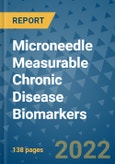Biomarkers are a key medical product development tool capable of facilitating development of medical products and spurring innovation. When used in the right context, biomarkers have the potential to help expedite patient access to safe and effective treatments by reducing the time and cost of clinical trials while maintaining patient protections. FDA encourages the integration of biomarkers in medical product development and approval, to facilitate the monitoring of FDA-regulated products, and their appropriate use in clinical practice. Biomarkers promise to reduce stagnation and foster innovation in the development of new medical products. A biomarker can be used as the basis for creating a routine diagnostic test for clinical use, after it has been approved as an in-vitro diagnostic. A biomarker can also be used to develop a companion diagnostic test that enables better decision-making on the use of a therapy that is tailored to the patient.
Biomarkers are biochemical molecules that indicate how the human body may react to certain active pharmaceutical ingredients (APIs) or different types of environmental factors. A simple but well-known example of the role of biomarkers in patient health and well-being would be food allergies. By identifying biomarkers in human physiology and understanding their role in drug therapy, allergies and immune reactions, caregivers are better able to help patients avoid drug side effects and to determine when a particular drug will produce the desired therapeutic effect for a given patient.
The FDA has assembled a database titled Table of Pharmacogenomic Biomarkers in Drug Labeling. This information resource illustrates identified relationships between drugs and biomarkers. Knowing which patients exhibit certain types of biomarkers is therefore desirable. Researchers and investigators are interested in finding ways to identify, measure and quantify biomarkers in ways that are non-invasive, or at least minimally invasive to minimize any discomfort to the patient.
Microneedles are one of the ways being explored to sample, measure and quantify biomarkers for specific diseases. Using microneedles to collect biomarkers in the interstitial fluid (ISF) can be an inexpensive and rapid method for assessing the role of biomarkers in therapeutics and disease management.
This report covers these areas and describes the current state of technology.
Biomarkers are biochemical molecules that indicate how the human body may react to certain active pharmaceutical ingredients (APIs) or different types of environmental factors. A simple but well-known example of the role of biomarkers in patient health and well-being would be food allergies. By identifying biomarkers in human physiology and understanding their role in drug therapy, allergies and immune reactions, caregivers are better able to help patients avoid drug side effects and to determine when a particular drug will produce the desired therapeutic effect for a given patient.
The FDA has assembled a database titled Table of Pharmacogenomic Biomarkers in Drug Labeling. This information resource illustrates identified relationships between drugs and biomarkers. Knowing which patients exhibit certain types of biomarkers is therefore desirable. Researchers and investigators are interested in finding ways to identify, measure and quantify biomarkers in ways that are non-invasive, or at least minimally invasive to minimize any discomfort to the patient.
Microneedles are one of the ways being explored to sample, measure and quantify biomarkers for specific diseases. Using microneedles to collect biomarkers in the interstitial fluid (ISF) can be an inexpensive and rapid method for assessing the role of biomarkers in therapeutics and disease management.
This report covers these areas and describes the current state of technology.
Microneedle Measurable Chronic Disease Biomarkers - What You Will Learn
- What companies are active in the microneedle diagnostics segments, what distinguishes their technology, and what is their market presence?
- What are the identified and verified chronic disease biomarkers, and what are their properties ?
- What are the major factors that are influencing interest in chronic disease biomarkers?
- What are the design factors, material selection issues, technologies, and market development issues for microneedles capable of capturing and identifying chronic disease biomarkers?
- What are the important therapeutic markets for microneedle measurable chronic disease biomarkers? What is their market potential?
- What are the significant economic, technology, and regulatory factors affecting the market for diagnostic microneedles?
Table of Contents
Executive Summary
Microneedle Product Categories
Microneedle Diagnostics - Design Factors
Microneedle Fabrication
Diagnostic Microneedle Device Analysis
Opportunities Extend Across Numerous Therapeutic Areas
Key Therapeutic Sectors
Company Profiles








